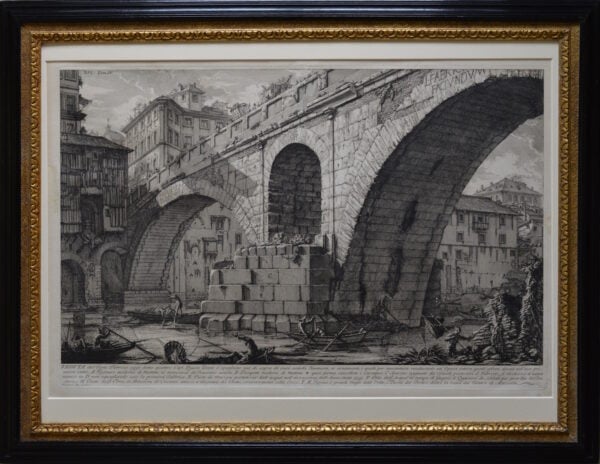Piranesi, Giovanni Battista (1720-1778)
Italian engraver and architect, is best known for his etchings of ancient and baroque Rome and grandiose architectural constructions of his own imagination.
born on Oct. 4, 1720, at Mojano di Mestre near Venice, the son of a stonemason. His early training in Venice under his uncle, Matteo Lucchesi, an architectural engineer, gave Piranesi a grasp of the means of masonry construction—scaffolding, winches, hawsers, pulleys, and chains—that stayed with him the rest of his life. His understanding of the vocabulary of classicism came largely from Andrea Palladio's book on architecture; his knowledge of architectural renderings he drew in part from Ferdinando Bibiena's book on civil architecture (1711); and his manner of placing buildings on a diagonal, sharply foreshortened, probably came from contemporary Venetian stage design.
In 1740 Piranesi went to Rome as a draftsman on the staff of the Venetian ambassador, Marco Foscarini. In Rome he learned to etch from Giuseppe Vasi. Trained as an architect but unable to find commissions, Piranesi published in 1743 a book of prints of imaginary buildings of enormous scale, inspired by the architecture of imperial Rome. The project was a financial failure.
By 1744 Piranesi was back in Venice, probably working in the studio of Giovanni Battista Tiepolo. From this period date Piranesi's etchings called grotesques: rococo shapes interlaced with fragments of ancient ruins. He returned to Rome in 1745, this time to stay. He took a consignment of prints (not his own) with him to sell as a publisher's agent and thus was able to get a financial foothold.
In 1745 Piranesi's first real success came with his Imaginary Prisons, 16 large plates that are often considered his masterpieces. "Only a stage-struck engineer, " wrote Hyatt Mayor (1952), "could have conjured up these endless aisles, these beams draped with tons of chain, these gangplanks teetering from arch to arch, these piers that stand like beacons for exploring loftiness and light. … Piranesi rendered such more-than-Roman immensities like a true Venetian by letting his etching needle scribble and zigzag until it sketched areas of shade as translucent as a Guardi wash." Later, when he reworked the copperplates, he made the shapes sharper and darker, creating new drama but destroying the translucency of the light.
Piranesi's next enterprise was to record the ruins of ancient Rome. It was to be the biggest project of his life. In 1756, after more intensive archeological studies than any known previously, studies that were much implemented by his knowledge of civil engineering, Piranesi published his Roman Antiquities, four huge volumes containing over 200 folio plates. It won him immediate and widespread fame. He was made an honorary member of the Society of Antiquaries in London in 1757. In Rome the painters welcomed him into the Academy of St. Luke in 1761.
The only architectural work Piranesi executed was for Cardinal Giovanni Battista Rezzonico, Grand Prior of the Knights of Malta. He completely remodeled the church that belongs to that order, St. Maria del Priorato (1764-1766). The decorative program he devised for the church is outstanding in its originality. Classical motifs, combined in un-classical ways, are commingled with banners, shields, warship prows, arrows, and musical instruments in such a way as to produce an extraordinarily rich mélange of crisp, angular, two-dimensional patterns carried out in stucco reliefs.
The system of ornamentation that Piranesi invented for the church he elaborated and disseminated through a new set of engravings that he published under the title Diverse Manners of Ornamenting Houses … (1769). It became, a generation later, the basis for the style known today as Empire. At a much earlier date it was introduced into England by Piranesi's friend Robert Adam.
Throughout most of his adult life Piranesi made etchings of views of the city; not only its antiquities, such as the Pantheon, but also its contemporary masterpieces such as the Capitoline and Piazza Navona. The scenes are animated with tiny, frail, fluttering figures.
On Nov. 9, 1778, while making drawings of the newly discovered temples at Paestum, Piranesi died. Long before then his prints of his adopted city had caught the imagination of much of Europe. In 1771 Horace Walpole urged his fellow Englishmen to "study the sublime dreams of Piranesi, who seems to have conceived visions of Rome beyond what it boasted even in the meridian of its splendour. Savage as Salvator Rosa, fierce as Michelangelo, and exuberant as Rubens, he has imagined scenes that would startle geometry, and exhaust the Indies to realize."



